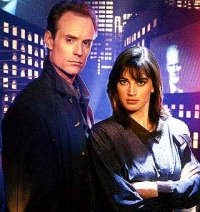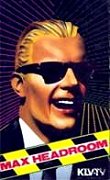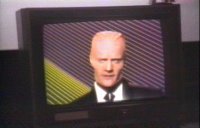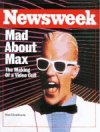|
History
 Max Headroom was one of the most innovative science
fiction series ever produced for American television, an ambitious
attempt to build upon the cyberpunk movement in science fiction
literature. The character of Max Headroom, the series's unlikely
cybernetic protagonist, was originally introduced in a 1984 British
television movie, produced by Peter Wagg, and starring Canadian
actor Matt Frewer. ABC brought the series to American television in
March 1987, refilming the original movie as a pilot but recasting
most of the secondary roles. The ABC series attracted critical
acclaim and a cult following, but only lasted for fourteen episodes.
The anarchic and irreverent Max went on to become an advertising
spokesman for Coca-Cola and to host his own talk show on the Cinemax
cable network.
Max Headroom was one of the most innovative science
fiction series ever produced for American television, an ambitious
attempt to build upon the cyberpunk movement in science fiction
literature. The character of Max Headroom, the series's unlikely
cybernetic protagonist, was originally introduced in a 1984 British
television movie, produced by Peter Wagg, and starring Canadian
actor Matt Frewer. ABC brought the series to American television in
March 1987, refilming the original movie as a pilot but recasting
most of the secondary roles. The ABC series attracted critical
acclaim and a cult following, but only lasted for fourteen episodes.
The anarchic and irreverent Max went on to become an advertising
spokesman for Coca-Cola and to host his own talk show on the Cinemax
cable network.
 The
original British telefilm appeared just one year after the
publication of William Gibson's Neuromancer, the novel which
brought public attention to the cyberpunk movement and introduced
the term, "cyberspace" into the English language. Influenced by
films, such as The Road Warrior and Bladerunner, the
cyberpunks adopted a taunt, intense, and pulpy writing style, based
on brisk yet detailed representations of a near future populated by
multi-national corporations, colorful youth gangs, and computer
hacker protagonists. Their most important theme was the total fusion
of human and machine intelligences. Writers like Gibson, Bruce
Sterling, Rudy Rucker, and Pat Cadigan, developed a shared set of
themes and images, which were freely adopted by Max Headroom.
The
original British telefilm appeared just one year after the
publication of William Gibson's Neuromancer, the novel which
brought public attention to the cyberpunk movement and introduced
the term, "cyberspace" into the English language. Influenced by
films, such as The Road Warrior and Bladerunner, the
cyberpunks adopted a taunt, intense, and pulpy writing style, based
on brisk yet detailed representations of a near future populated by
multi-national corporations, colorful youth gangs, and computer
hacker protagonists. Their most important theme was the total fusion
of human and machine intelligences. Writers like Gibson, Bruce
Sterling, Rudy Rucker, and Pat Cadigan, developed a shared set of
themes and images, which were freely adopted by Max Headroom.
 Set "twenty minutes in the future," Max Headroom depicted a
society of harsh class inequalities where predators roam the street
looking for unsuspecting citizens who can be sold for parts to
black-market "body banks." Max inhabits a world ruled by Zik-Zak and
other powerful corporations locked in a ruthless competition for
consumer dollars and television rating points. In the opening
episode, Network 22 dominates the airwaves through its use of
blipverts, which compress thirty seconds of commercial information
into three seconds. Blipverts can cause neural overstimulation and
(more rarely) spontaneous combustion in more sedate viewers. Other
episodes centered around the high crime of zipping (interrupting a
network signal) and neurostim (a cheap burger pak give-away which
hypnotizes people into irrational acts of consumption). We encounter
blanks, a subversive underground of have-nots, who have somehow
dodged incorporation into the massive databanks kept on individual
citizens.
Set "twenty minutes in the future," Max Headroom depicted a
society of harsh class inequalities where predators roam the street
looking for unsuspecting citizens who can be sold for parts to
black-market "body banks." Max inhabits a world ruled by Zik-Zak and
other powerful corporations locked in a ruthless competition for
consumer dollars and television rating points. In the opening
episode, Network 22 dominates the airwaves through its use of
blipverts, which compress thirty seconds of commercial information
into three seconds. Blipverts can cause neural overstimulation and
(more rarely) spontaneous combustion in more sedate viewers. Other
episodes centered around the high crime of zipping (interrupting a
network signal) and neurostim (a cheap burger pak give-away which
hypnotizes people into irrational acts of consumption). We encounter
blanks, a subversive underground of have-nots, who have somehow
dodged incorporation into the massive databanks kept on individual
citizens.
 At the core of this dizzying and colorful world was Edison Carter, an
idealistic Network 24 reporter who takes his portable minicam into
the streets and the boardrooms to expose corruption and
consumer-exploitation which, in most episodes, led him back to the
front offices of his own network. Edison's path is guided by Theora
Jones, his computer operator, whose hacker skills allow him to stay
one step ahead of the security systems--at least most of the
time--and Bryce Lynch, the amoral boy wonder and computer wizard. He
is aided in his adventures by Blank Reg, the punked-out head of a
pirate television operation, BigTime Television. Edison's alter-ego,
Max Headroom, is a cybernetic imprint of the reporter's memories and
personality who comes to "live" within computers, television
programs and other electronic environments. There he becomes noted
for his sputtering speech style, his disrespect for authority, and
his penchant for profound nonsequiters.
At the core of this dizzying and colorful world was Edison Carter, an
idealistic Network 24 reporter who takes his portable minicam into
the streets and the boardrooms to expose corruption and
consumer-exploitation which, in most episodes, led him back to the
front offices of his own network. Edison's path is guided by Theora
Jones, his computer operator, whose hacker skills allow him to stay
one step ahead of the security systems--at least most of the
time--and Bryce Lynch, the amoral boy wonder and computer wizard. He
is aided in his adventures by Blank Reg, the punked-out head of a
pirate television operation, BigTime Television. Edison's alter-ego,
Max Headroom, is a cybernetic imprint of the reporter's memories and
personality who comes to "live" within computers, television
programs and other electronic environments. There he becomes noted
for his sputtering speech style, his disrespect for authority, and
his penchant for profound nonsequiters.
 Critics admired the series' self-reflexivity, its willingness
to pose questions about television networks and their often
unethical and cynical exploitation of the ratings game, and its
parody of game shows, political advertising, tele-evangelism, news
coverage, and commercials. Influenced by MTV, the series's
quick-paced editing and intense visual style were also viewed as
innovative, creating a televisual equivalent of the vivid and
intense cyberpunk writing style. This series's self-conscious parody
of television conventions and its conception of a "society of
spectacle" was considered emblematic of the "postmodern condition,"
making it a favorite of academic writers as well. Their interest was
only intensified by Max's move from science fiction to advertising
and to talk television, where this non-human celebrity (commodity)
traded barbed comments with other talk-show-made celebrities, such
as Doctor Ruth, Robin Leach, Don King, and Paul Schaffer. Subsequent
series, such as Oliver Stone's Wild Palms or VR, have
sought to bring aspects of cyberpunk to television, but none have
done it with Max Headroom's verve, imagination, and
faithfulness to core cyberpunk themes.
Critics admired the series' self-reflexivity, its willingness
to pose questions about television networks and their often
unethical and cynical exploitation of the ratings game, and its
parody of game shows, political advertising, tele-evangelism, news
coverage, and commercials. Influenced by MTV, the series's
quick-paced editing and intense visual style were also viewed as
innovative, creating a televisual equivalent of the vivid and
intense cyberpunk writing style. This series's self-conscious parody
of television conventions and its conception of a "society of
spectacle" was considered emblematic of the "postmodern condition,"
making it a favorite of academic writers as well. Their interest was
only intensified by Max's move from science fiction to advertising
and to talk television, where this non-human celebrity (commodity)
traded barbed comments with other talk-show-made celebrities, such
as Doctor Ruth, Robin Leach, Don King, and Paul Schaffer. Subsequent
series, such as Oliver Stone's Wild Palms or VR, have
sought to bring aspects of cyberpunk to television, but none have
done it with Max Headroom's verve, imagination, and
faithfulness to core cyberpunk themes.
 Max Headroom appeared on the cover of the April 20, 1987 edition of Newsweek
Magazine which also featured an extensive article about the character, his
history and a peek at the Max headroom television show. Along with the cover
story is a short article about Amanda Pays and her character Theora Jones.
The articles are dated with references to New Coke and speculations on the
future of the character and the television show. In spite of this this is a
wonderful time capsule that captures the public awareness of the character
at the peak of his popularity The articles have been preserved on this site
and can be read here.
Max Headroom appeared on the cover of the April 20, 1987 edition of Newsweek
Magazine which also featured an extensive article about the character, his
history and a peek at the Max headroom television show. Along with the cover
story is a short article about Amanda Pays and her character Theora Jones.
The articles are dated with references to New Coke and speculations on the
future of the character and the television show. In spite of this this is a
wonderful time capsule that captures the public awareness of the character
at the peak of his popularity The articles have been preserved on this site
and can be read here.
|